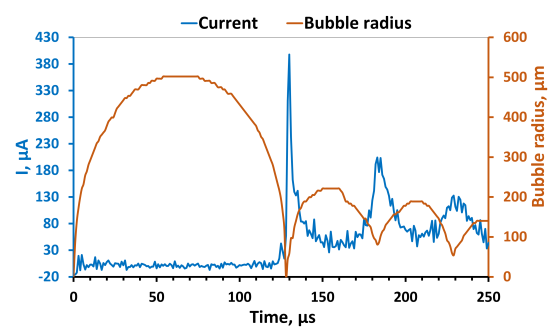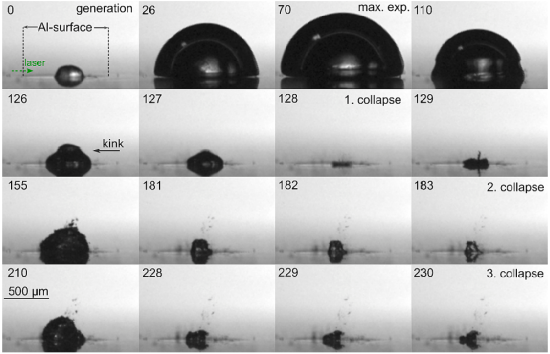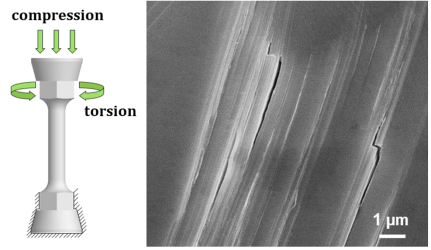Current & Completed Projects
Current Research Projects
Developing methods for in-situ and real-time measurement of surface damage induced by cavitation using electrochemical techniques
Project number: DFG 529857700
Expected duration: 01.01.2024 – 31.12.2026
Abstract:
In-situ real-time detection of cavitation damage has been a challenge for many years. Among the non-invasive techniques, optical inspection may not be possible as relevant surfaces may be covered by cavitation structures or optically not accessible at all. The erosion-enhanced corrosion during cavitation, on the other hand, can be used for real-time in-situ and even non-invasive detection of cavitation damage. Here, electrochemical techniques, especially those that are sensitive to high-speed short-time changes on the surface, should be applied.
In this research project, the effects and interrelations of erosion and corrosion of technical alloys under ultrasonic cavitation and single bubble cavitation will be studied on different time and length scales using various electrochemical techniques. High-speed cameras will be used to reveal details of bubble collapse and correlate them with high-time resolution electrochemical signals from the chronoamperometry technique. Observing open circuit potential (OCP) and applying external anodic and cathodic potentials will reveal the influence of repassivation kinetics, the nature of passive films, and other effects of electrochemical behavior on erosion-corrosion damage. As we use and compare the various electrochemical techniques under different testing conditions (sample size, target alloy, and applied potential), it will be possible to assess and verify the capability of these techniques, especially high-speed chronoamperometry, for measurement of cavitation damage real-time in-situ either non-invasive at free potential or invasive under potentiostatic conditions.


M. Abedini, S. Hanke, F. Reuter, In situ measurement of cavitation damage from single bubble collapse using high-speed chronoamperometry, Ultrasonics Sonochemistry 92 (2023) 106272.
Research area: tribocorrosion, cavitation, electrochemical measurements, high-speed imaging, high-speed chronoamperometry
Contact: Dr. Morteza Abedini
Nanoscale interaction of microstructure and tribological damage in additively manufactured high-nitrogen alloy austenites for medical applications
Funding: MERCUR KOOPERATION
Duration: May, 5th, 2022 – April 30th, 2023
Abstract:
High nitrogen alloyed austenitic steels (HNA) have a unique combination of highest strength, toughness and corrosion resistance due to high contents of the elements carbon (C) and nitrogen (N). HNA therefore offer potential for use particularly in medical technology and the hydrogen economy. Processing by metallic 3D printing using powder bed fusion - laser beam (PBF-LB) also enables resource-efficient use of HNA in lightweight construction by replacing austenites of lower strength. In this project, the complex nano- and microstructure formation in PBF-LB, as well as the interaction between microstructure and tribological behavior are investigated using HNA X40MnCrMoN21-18-2. Microstructure formation is traced from the metal powder, through the PBF-LB process and a thermal post-process down to the atomic level. Further, the influence of the PBF-LB microstructure on damage accumulation under sliding wear and cavitation is elucidated. This yields important insights into peculiarities in the behavior of HNA in additively manufactured components.
Optical in-situ analysis of the cavitation damage on technical alloys under repeated single bubbles
Project number: DFG 451715773
Expected duration: April 1st, 2021 – March 31st, 2024
Abstract:
Cavitation - the formation and collapse of gas bubbles in liquids - can damage even high-strength surfaces in the long term. The resistance of materials to cavitation is typically determined using ultrasonic sonotrodes that generate clouds of bubbles of various sizes. Alternatively, it is possible to use focused laser pulses to create single bubbles that are spatiotemporally precisely reproducible. So far, however, it is unclear how these results can be applied to higher-strength materials.
In this project, the microscopically uncontrolled damage caused by acoustic cavitation is combined with the precisely reproducible load from single bubbles. Series of single bubbles act as a load collective on surfaces of high-strength alloys. By recording the bubble collapse with a high-speed camera and the incremental increase in damage with an integrated light microscope, the process of material damage can be traced in detail. High-resolution ex-situ microscopy then allows identifying the microstructural damage mechanisms. In order to correlate the results on material damage with what is already known in material science, standard tests with a sonotrode are carried out in parallel.

S. Hanke, S.A. Kaiser, Comparison of Damage Mechanisms: Acoustic Cavitation versus Series of Single Laser-Induced Bubbles, Wear, available online 3 February 2021, No. 203641, In Press
Research area: tribology, wear mechanisms, optical diagnostics, image analysis
Contact: Dr.-Ing. Stefanie Hanke
Collaborator: Prof. Dr. Sebastian Kaiser
Deformation and failure mechanisms in austenitic steel under coupled compressive and torsional loading
Project number: DFG 441180620
Duration: October 1st, 2020 – September 30th, 2023
Abstract:
In practice, components are often exposed to multi-axial mechanical loads, typically occurring as a function of time and reversing. Experimental investigations under such complex load collectives are very time-consuming, so that the mechanisms that lead to plastic deformation and failure of materials under such conditions are only poorly understood. As a result, there is also an uncertainty as to whether common solid-state mechanical failure hypotheses are valid under these conditions.
In this project, the deformation and damage mechanisms in a high nitrogen austenitic steel under superimposed pressure and cyclic torsional loads are experimentally investigated. Influences of the specific load condition on the microstructural mechanisms of strain and damage accumulation are analyzed by high-resolution microscopy. Based on the experimental results, a constitutive model within the framework of crystal plasticity is formulated by the cooperation partner at Ruhr-University Bochum, which reliably describes cyclic plasticity and damage under multiaxial loads on the microstructure level.

Research area: plastic deformation, austenitic steel, damage mechanisms
Contact: Dr.-Ing. Stefanie Hanke
Cooperation Partner: Prof. Dr. Alexander Hartmaier, alle relevanten Informationen finden Sie hier
Completed Research Projects
|
Influence of Mg and Si Content in Aluminium Alloys on Severe Plastic Deformation Behaviour during Solid-State Coating Deposition using Friction Surfacing Support code: HA 7834/1-1 Duration: Mai 5th, 2017 – April 30th, 2020 Abstract: In the scope of this project 6 custom-made Aluminium alloys are processed by Friction Surfacing (FS), in cooperation with the Helmholtz-Zentrum Geesthacht. Each of these alloys only differs in its content of Mg or Si, allowing a direct comparison and therewith the investigation of the effects of those alloying elements on the material behaviour. The Si content will be raised up to 17.5 wt%, providing undissolvable hard phases during processing, which will further influence the deformation and recrystallization mechanisms. Besides examining process forces and coating geometry, XRD, EBSD and TEM investigations of the microstructural mechanisms of plastic deformation will be carried out, and correlated with the material behaviour during FS. Research area: Materials Science, Severe Plastic Deformation Contact: Dr.-Ing. Stefanie Hanke |
|
Metallurgical mechanisms of cyclic plastic deformation by High Pressure Torsional Fatigue (HPTF) Program for the Advancement of Excellent Young Researchers (by University Duisburg-Essen) Duration: August 1st, 2017 – December 31st, 2018 Abstract: Research area: Materials Science, Severe Plastic Deformation Contact: Dr.-Ing. Stefanie Hanke |
|
Monitoring and Quantification of Cavitation Corrosion Erosion through Electrochemical Noise Method DFG – Grants to Support the Initiation of International Collaboration Project number: 407436768 Duration: June 1st, 2018 – August 31st, 2018 Abstract: In a first step, the possibility of monitoring and quantification of cavitation corrosion erosion using a non-destructive method, i.e., the electrochemical noise technique (ECN) is investigated. A possible application to marine components is of strong interest for future research, aiming at monitoring the material deterioration and developing methods to predict the remaining service life. In this project, a collaboration between Dr.-Ing. Stefanie Hanke (Materials Science and Engineering, Uni DUE), Dr. Morteza Abedini (Department of Metallurgy and Materials Engineering, University of Kashan, Iran) and Dr. rer.nat. Fabian Reuter (Institute of Ship Technology, Ocean Engineering and Transport Systems, Uni DUE) is initiated. Research area: Tribology, Corrosion, Cavitation Contact: Dr.-Ing. Stefanie Hanke |
|
Bionische Werkzeugkonzepte für die schädigungsfreie Bearbeitung von modernen faserverstärkten Hochleistungspolymeren Support Code: Pr-2012-0002 Duration: Januar 1st, 2013 - Dezember 31st, 2014 Abstract: Contact: Dipl.-Ing. Priska Stemmer Research area: Material Science |
|
Erhöhung von Leistungsdichte und Lebensdauer hochbelasteter Funktionsflächen durch spanende Oberflächenkonditionierung Support Code: Pr-2011-0002 Duration: Januar 1st, 2012 - Dezember 31st, 2013 Abstract: Contact: Dipl.-Ing. Priska Stemmer (Mikroskopy); Dipl.-Ing. Daniel Stickel (Wear experiments) Research area: Material Science |
|
Strukturbildung und Selbstregenerationsmechanismen der triboinduzierten Randschicht von Metallen Duration: July 1st, 2011 - June 30th, 2013 Abstract: Contact: Dipl.-Ing. Priska Stemmer Research area: Material Science |
|
Einladungen von ost- und mitteleuropäischen Wissenschaftlern nach Deutschland Support Code: DFG 436 POL 17/10/04, DFG 436 POL 17/02/03, DFG 436 POL 17/06/02, DFG 436 POL 17/01/01, DFG 436 POL 17/12/00, DFG 436 POL 17/02/06 Abstract: Research area: Material Science Contact: Priv.-Doz. Dr.Ing.habil. Sabine Weiß |
|
Wissenschaftliche Zusammenarbeit mit Ägypten Projekt: öffentlich gefördertes Forschungsprojekt Support Code: 445 AGY 112/9/06 Abstract:
Research Area: Material Science Contact: Priv.-Doz. Dr.Ing.habil. Sabine Weiß |
|
Friction Stir Welding Equipment for Joining Large Steel Structures - FSW Steel, Joint Project supported by the Ministry of Economy and Technology (BMWi) Subproject: "Development of Efficient Tools for Friction Stir Welding of Steel" Support Code: VP2095003PK9 Duration: Dec. 1st, 2009 - Oct. 31st, 2011 Associate partners: SLV Berlin-Brandenburg, Ingenieurtechnik und Maschinenbau GmbH, Lippold Hydraulik und Wälzlager GmbH, Helmholtz-Zentrum Geesthacht, Materion GmbH, H.Loitz - Robotik GbR Abstract: Starting by determining process parameters for joining thin steel structures on experimental welding machines, the necessary parameters for future equipment and welding tools are identified. Concurrent to the development of new tools (materials, design, surface treatment), the concept for a production facility for joining large steel structures of a thickness of 3 to 4 mm is created. Solutions for the main components for clamping, process control and tool fixture are developed, prototypes are produced, integrated into the equipment and tested on lab scale. The outcome of this project will be efficient friction stir welding tools as well as a functioning example for a production facility. Those will be the basis for the following design, construction and commercialisation of production facilities for friction stir welding of thin steel sheets. Research area: Tooling Contact: M. Sc. Stefanie Hanke Website: www.innowelding.de |
|
Fatigue behaviour of Cu-based single and stranded wires Associate partner: Deutsches Kupferinstitut Berufsverband e.V. & International Copper Association Abstract: Research area: Material Science Contact: Dipl.-Ing. Michael Schymura |
|
Metal Friction Surface Welding Project: Ford- University Research Program Abstract: Friction Surfacing opens up new possibilities for the repair of worn and damaged components. This process is also potentially useful as an alternative surfacing process as it allows for a compromise between the bulk substrate, which can be dictated by strength or economic constraint, and that of the surface, which can be altered by the application of selective materials to form a protective barrier against wear and corrosion. The possibility of forming a high quality and regular layer onto a substrate by Friction Surfacing process depends of the selection of appropriate welding parameters. The reproducibility of the weld however, depends of the controllability of the machines used for this purpose. The Friction Surfacing Process can be divided in two Phases: Pre-heating Phase and Welding Phase. During the Pre-heating stage the rotating stud is pressed onto the substrate, the heat is developed due to the energy generated by friction between the substrate and the rotating stud. The temperature rises just below the melting point of the material, where the yielding strength of the material decreases and the shear stress produced in the stud is high enough to enable plastic deformation in the material. The welding phase of the process is responsible for the production of the coating layer onto the plate by start of the transversal motion of the rotating rod. In this phase a quasi-steady thermal condition is reached influencing the properties of the HAZ formed. At this point the dimensional properties and the quality of the layer formed are significantly influenced by the transversal speed, rotational speed and the load applied. When the weld length required is reached, the transversal and rotation motion is stopped and the axial load is maintained, assuring the high bonding quality of the end of the layer. The projected benefits from this project are cost reduction due to reduced maintenance time and enabling low cost tool material. Further, an improved quality due to reduced tool wear and scratches is expected. The implementation of this advanced technology, which can be used on machines which are already available (milling) with low investment costs is regarded as new solution for well known challenges. Research area: Tooling Contact: M.Sc. Stefanie Hanke |
|
Nanocrystalline Composite Coatings with nano textured surface for Cylinder Running Surfaces of highly stressed Gasoline and Diesel Engines - NaCoLab Support Code: BMBF 03X0003K Duration: Jun. 1st, 2005 - Mai 31th, 2008 Abstract: Within this project a complete, innovative manufacturing chain for coating aluminium crank cases with this nanocrystalline material is developed. It includes the mechanical roughening of the substrate, thermal spraying of the filler wire feedstock and finally the surface finish by honing. The institute of product engineering, materials science and engineering, advances the furthering of knowledge and understanding of the tribosystem piston ring - cylinder running surface by investigating the acting wear mechanisms. Running-in and wear influence the formation of the lubrication oil film in the contact zone. This results in differing friction losses, emissions and oil consumption which are significantly related to the durability of the motor. Advancing simulation tools to predict running-in and wear within the highly stressed positions top and bottom dead center is an additional objective within this project. Research area: Automotive Contact: Dipl.-Ing. Mareike Hahn |
|
Solving Steel Welding Problems by the use of Friction Stir (SOLVSTIR) Project: EU-Projekt Support Code: RFS-PR-03077 Abstract: Research area: Tooling Contact: Dr.-Ing. Christian Zietsch |
|
Reducing the Emission of Wear Debris in Metal on Metal Hip Joints by Means of Microstructured Surfaces. Project: Industrial project Duration: Jan. 1st, 2007 - Dec. 31th, 2008 Associate partner: Zimmer GmbH Abstract: Research area: Biomedical Engineering Contact: Dipl.-Ing. Robin Pourzal |
|
Microstructure and Deformation Behavior of Coronary Stents under Fatigue Project: Publicly funded research project Support Code: DFG FI495/9-1, DFG FI495/9-2, DFG WE2671/1-3 Abstract: Forschungsbereich: Biomedical Technology Ansprechpartner: Priv.-Doz. Dr.-Ing. Sabine Weiß |

